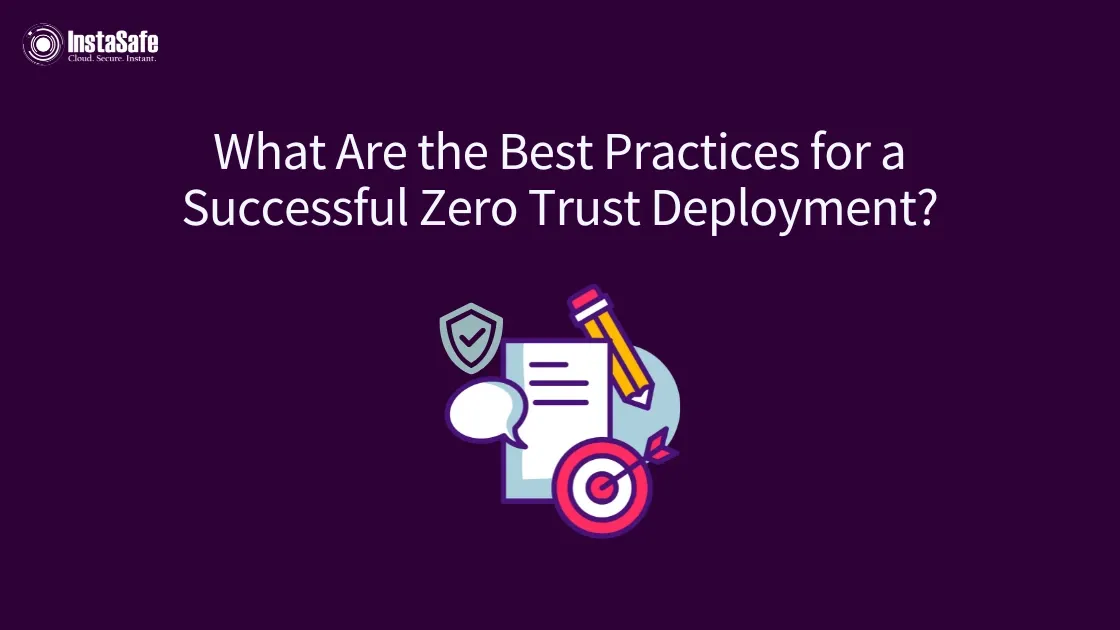What Are the Best Practices for a Successful Zero Trust Deployment?

The traditional security models focus heavily on external threats while automatically trusting internal network traffic. However, recent security incidents show that insider threats can cause more damage than external attacks. This is where it becomes important for every organisation to deploy a zero-trust security framework.
Zero-trust deployment is not just another cybersecurity trend. It is a complete shift in how organisations approach security. At its core, a zero-trust strategy treats all users, devices and connections as potential threats, regardless of whether they are inside or outside the network perimeter.
This Zero-Trust deployment guide explains the best practices for a successful zero-trust deployment.
Zero-Trust Deployment Guide: Best Practices to Follow
1. Identify and Classify Your Data
The best practice for any zero-trust deployment is knowing exactly what you are protecting. Organisations must identify all sensitive data and classify it according to importance and sensitivity.
This inventory forms the foundation of your protection strategy, as you can not secure what you don't know exists. Thus, map where your valuable data resides, how it flows through your organisation and who needs access to it. This clarity helps prioritise protection efforts around your most critical assets.
2. Secure Executive Sponsorship
Successful zero-trust best practices always include gaining leadership support. Zero-trust signifies a dramatic change in security strategy that impacts the whole company. Securing executive sponsorship ensures you have the authority, budget and organisational alignment needed for success.
Leaders must understand the value of zero trust and communicate its importance across the organisation. This top-down support makes implementation smoother and increases adoption rates.
3. Establish Clear Metrics and Goals
Define what success looks like before beginning your zero-trust deployment process. Establish baseline measurements of your current security posture, then set specific, measurable goals for improvement.
These might include reducing security incidents, decreasing unauthorised access attempts or improving compliance scores. Having clear metrics helps show value and guides your implementation priorities throughout the journey.
4. Start With Your Most Critical Assets
A fundamental zero-trust best practice is to begin with your most valuable assets rather than trying to secure everything at once. Identify your critical assets — the data and systems that would cause the most harm if compromised — and focus your initial implementation efforts there. This approach delivers the highest security and sets a path for a broader rollout.
5. Implement Strong Identity and Access Management
The cornerstone of zero-trust deployment is knowing exactly who is accessing your systems. Make sure to implement multi-factor authentication for all users, especially for access to sensitive resources.
Move beyond simple password requirements to include additional verification factors like biometrics, hardware tokens, or authenticator apps. Further, centralise identity management to ensure consistent enforcement of authentication policies across all applications and services.
6. Apply Least Privilege Access Controls
Zero-trust best practices include limiting user access permissions to a minimum. Thus, review current access privileges and reduce them to only what each person needs to perform their job.
Moreover, it is important to implement time-limited access for sensitive systems rather than giving permanent permissions. Further, audit access rights regularly to identify and remove unnecessary privileges. This is especially important when employees change roles or leave the organisation.
7. Deploy Micro-segmentation
Dividing your network into smaller, isolated segments significantly strengthens your zero-trust strategy. Consider creating zones based on the sensitivity of resources and limit traffic between these zones.
This approach prevents potential breaches by preventing lateral movement across your network. Even if attackers gain access to one part, micro-segmentation prevents them from moving to others, substantially limiting potential damage.
8. Encrypt Data in Transit and at Rest
Data protection is a non-negotiable element of zero-trust best practices. You must implement strong encryption for sensitive data while it is stored and when it is transmitted between systems.
This ensures that even if unauthorised access occurs, the information remains unreadable and unusable. However, these encryption standards should be regularly reviewed and updated to maintain protection against evolving threats and comply with changing regulations.
9. Enable Continuous Monitoring and Verification
Effective zero-trust deployment requires ongoing verification rather than one-time authentication. Make sure to implement systems that continuously monitor user behaviour, network traffic and system activities to detect anomalies.
Further, use advanced analytics to establish normal behaviour patterns and identify potential threats when deviations occur. This type of constant attention provides early discovery and reaction to suspicious activity before significant breaches.
10. Implement Device Validation
As part of your zero-trust strategy, every device accessing your network must undergo security verification. To ensure this, enforce device compliance checks before granting access to resources, regardless of whether the devices are company-owned or personal.
Also, verify patch levels, security software status and configuration compliance before allowing connections. When possible, implement automated remediation to bring non-compliant devices up to standards before permitting access.
Zero-Trust Deployment: Overcoming Common Challenges
The successful zero-trust deployment comes with hurdles that require planning and persistence:
Managing Complexity
Zero-trust deployment can seem overwhelming, especially for larger organisations with complex environments. To track progress, break implementation into manageable stages with clear milestones. Moreover, documenting procedures carefully ensures consistency and prepares for automation.
Balancing Security and Usability
Strong security should not create significant barriers to legitimate work. Look for security solutions that minimise user friction while maintaining protection. You may implement single sign-on to reduce authentication fatigue and create streamlined processes for common access needs.
Securing Legacy Systems
Older systems often present significant challenges in zero-trust deployment because they were not designed with modern security principles in mind. Identify which legacy systems contain sensitive data or provide important functions. Once identified, extra protection layers should be added around these systems if they can not be updated.
Conclusion
Implementing zero-trust best practices requires commitment and a willingness to change traditional security approaches. By deploying a comprehensive zero-trust strategy that verifies every user, device and connection, organisations can significantly reduce their risk of data breaches.
With proper planning and a robust Zero Trust Network Access model, you can strengthen your security while supporting business growth and innovation.
At InstaSafe, we transform security paradigms with our reliable zero-trust innovation. Never trust, always verify — our platform authenticates every access request, protecting critical assets while enabling seamless productivity.
Contact us for more information!
